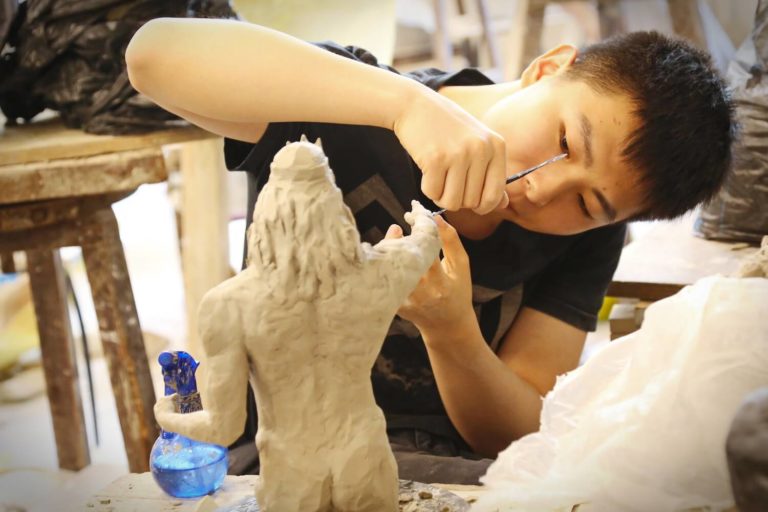Most students, regardless of age or background, truly enjoy participating in art. It is no surprise that most of us are visual learners. The appealing aspects of art are what capture our attention and keep us intently focused. Integrating art into the classroom is no different.
Benefits of Art
Art provides numerous benefits to students. It is actually quite astonishing to see the huge variety of skills that students can develop and gain from simply participating in art. These skills are not only beneficial during childhood, but they are also equally as important on into adulthood and useful in the real world. Let’s focus our attention on some of the important skills that students gain through participation in the arts.
Focus and Problem Solving
Students who participate in art strengthen their focus skills. Students must focus on the “problem” at hand. For visual art, that problem may be determining which art tools or materials will effectively create the picture that they have in their minds. For performance art, students may need accurate timing to come in on cue. Regardless of the art medium, students must stay in tune with what is happening in order to successfully complete their work.
Intrinsic Motivation
Intrinsic motivation is defined as doing something without expecting any external reward. Students will take part in art without any care as to whether or not they will be given recognition for their work. Additionally, art is not considered a chore or “work” for most students. Art creates a sense of enjoyment in students, and they naturally want to share in the fun. Students simply enjoy the process of creating art.
Self Expression and Creativity
In continuing with student enjoyment of art, students find art as an outlet for self-expression and creativity. There are no limits with art. Students can create whatever they so desire within the realms of their imagination. If they can see it, they can create it. Even the most timid of students can express themselves through art. It is a truly beautiful process to witness!
Confidence
From the fostering of self-expression and creativity comes increased student confidence! As stated before, there are no right or wrong ways to create art. Students develop a greater sense of self by expressing themselves openly and in their own way. It is also quite rewarding for students to share their art with others and see how it is accepted and enjoyed, thereby developing their interpersonal skills as well.
Promotes Engagement
Because art provides intrinsic motivation, students are more likely to be engaged. If a teacher provides an assignment with an art component, students who might normally struggle to participate suddenly find themselves engaged in the learning at hand. It also gives students a sense of excitement! From colors to creativity, art brings forth an increased desire to participate; thus, increasing student motivation.
Determination and Perseverance
Increased engagement and motivation equals increased determination and perseverance. When students start an art project, they are typically more determined to see it completed. Most elementary teachers can attest to the fact that many students are not happy when their work of art is interrupted before it has been completed. Through art, students want to see their ideas fully come to life.
Cooperation and Collaboration
Some art projects require students to work with others to see the project to fruition. Students must listen to the ideas of others and constructively combine ideas to effectively complete the project at hand. Skills of cooperation and collaboration will not only benefit the students during their school years, but they will most certainly be of use when entering their chosen career field as an adult.
Higher Academics
To state it plainly, art can make students smarter. This benefit is huge! Participation in art is highly beneficial to student performance in the classroom. Art requires use of multiple parts of the brain, thus, providing better overall brain usage in students.
How to Utilize Art in Student Learning
Art enhances student learning in the classroom. Teachers should integrate art as often as possible in order to better engage students in learning, increase excitement in the classroom, and keep them focused on the task at hand. Below are some additional ideas for how to utilize art in the classroom:
- One of the simplest ways to integrate art into the classroom is to allow students to create a book with pictures to tell a story that they have written. Students have to thoughtfully plan out the illustrations to ensure that they match the text on each page.
- Students can create paintings to represent different countries for a history project. This requires students to gain an in-depth understanding of the country’s culture, traditions, and environment.
- After completing a novel study or reading a book, students can integrate art by creating a picture to display the emotions produced by the story. Students can either focus on their own emotions experienced at the conclusion of the story or the emotions experienced by a main character.
- When introducing new vocabulary, an excellent strategy to help students better understand a word’s meaning is to allow them to create a word picture. Students colorfully write out the word. Then, they draw pictures to represent the word. Not only do students get a chance to create during this activity, they get practice with spelling a new word. This also helps students retain the word’s definition more effectively.
- Another excellent activity for arts integration is the creation of poetry. Students can write a poem from a teacher chosen topic. Then, students may illustrate their poems with pictures.




